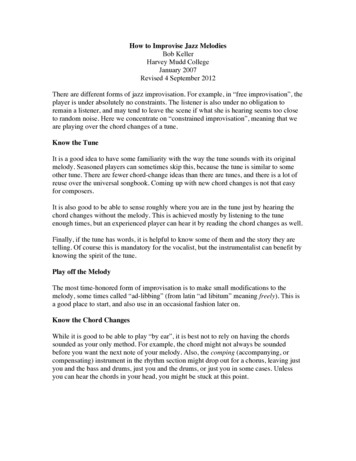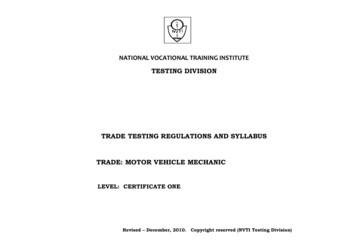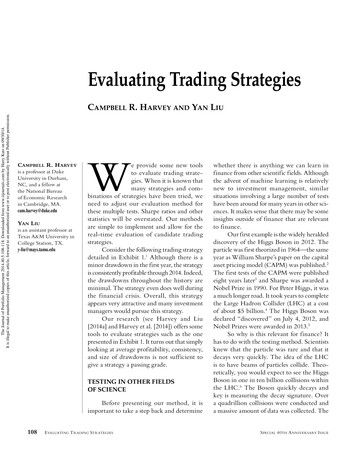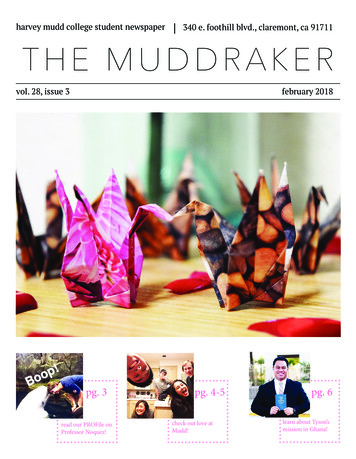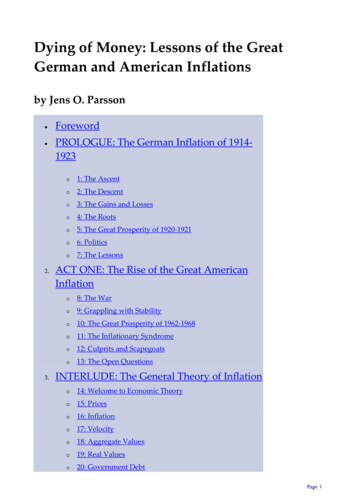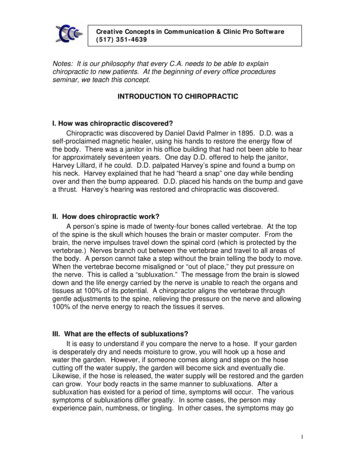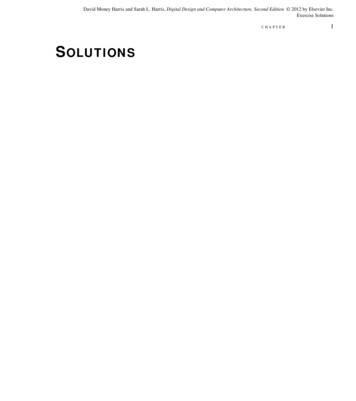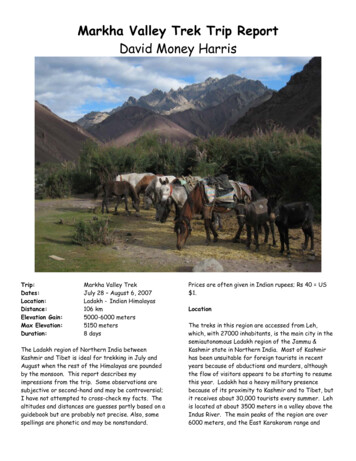
Transcription
Markha Valley Trek Trip ReportDavid Money HarrisTrip:Dates:Location:Distance:Elevation Gain:Max Elevation:Duration:Markha Valley TrekJuly 28 – August 6, 2007Ladakh - Indian Himalayas106 km5000-6000 meters5150 meters8 daysThe Ladakh region of Northern India betweenKashmir and Tibet is ideal for trekking in July andAugust when the rest of the Himalayas are poundedby the monsoon. This report describes myimpressions from the trip. Some observations aresubjective or second-hand and may be controversial;I have not attempted to cross-check my facts. Thealtitudes and distances are guesses partly based on aguidebook but are probably not precise. Also, somespellings are phonetic and may be nonstandard.Prices are often given in Indian rupees; Rs 40 US 1.LocationThe treks in this region are accessed from Leh,which, with 27000 inhabitants, is the main city in thesemiautonomous Ladakh region of the Jammu &Kashmir state in Northern India. Most of Kashmirhas been unsuitable for foreign tourists in recentyears because of abductions and murders, althoughthe flow of visitors appears to be starting to resumethis year. Ladakh has a heavy military presencebecause of its proximity to Kashmir and to Tibet, butit receives about 30,000 tourists every summer. Lehis located at about 3500 meters in a valley above theIndus River. The main peaks of the region are over6000 meters, and the East Karakoram range and
Great Himalayan Range host 7000 meter peaks thatmay be visible under good conditions.topo lines prove unnecessary and not all place namesare labeled. Now, most Leh bookstores sell goodtrekking maps and the Markha Valley trekking bookcontains an adequate map for Rs 200.Trekking AgenciesStok Kangri over the Indus Valley and Old City of LehWhen to GoMost trekking in Ladakh takes place in July andAugust. The region is in the rain shadow of theHimalayas and avoids the monsoon; it receives about4” of rain per year. The desert valleys are hot, whilethe passes and peaks can be cool and windy. June isfeasible, but passes will still be covered in snow andriver crossings will be more difficult. September isalso a time to avoid the crowds, but the weatherbecomes less stable and surprise blizzards can strike.ReferencesTwo good guides to the trek are Lonely Planet’sTrekking in the Indian Himalaya and Milestone Book’sTrekking in Ladakh - Markha Valley. Leh is a heavilytouristed city and has numerous good bookstores withmany guidebooks. The “Spiritual Guides” website onLeh IndianStates/Ladakh/Leh.htm) is full of handyfree and slightly outdated information along with anadvertisement for Yogi Abhaya’s Amazing ColonCleaning Program.MapsLonely Planet says that maps are not available in Indiaand so I went to significant effort and expense totrack down the US military U502 series maps NI 4308 ref Leh and NI 43-12 ref Martselang from EastView Cartographic (cartographic.com). These are theonly topographic maps that I could locate, but theSomewhere between 100 and 200 trekking agenciesare scattered around the main bazaar in Leh. Theyoffer guided treks, jeep tours, whitewater rafting,bike rides, and just about anything else you mightwant. Trekking agencies are not regulated by thegovernment and anyone can start one. I went withthe Ecological Footprint agency(ladakhecologicalfootprint.com). I also had lengthyconversations with Sonam Gyasto at the Lhari KarpoEcological Trek & Tours agency (www.eco-ladakh.com).Some of the other large and reputable agenciesinclude Rimo Expeditions (rimotreks.com), Dreamland(www.dreamladakh.com), and Snow LeopardAdventures (www.snowleopardadventures.com). InJuly and August, about 10 agencies depart for theMarkha Valley daily, so it is easy to arrange a trip onone or two day’s notice.A group guided trek costs about 40 / person / dayincluding all meals and gear rental. Bigger agenciescharge a little more. The quality of the food tends tobe proportional to the price. Higher end agenciesbring folding chairs and even tables for the clients,but this strikes me as an abuse of the pack animals.Plan to add 10-20% of the trip cost for tips to thestaff.Getting to LehThe easiest way to reach Leh is by air from Delhi.There are several daily flights in the summer by JetAirways, Indian Airlines, and Air Deccan, and sporadicflights in the off season. My fully refundable ticketson Jet cost about 200 each way with 3 weeksnotice, but careful buyers may be able to do half thatwith more advanced notice. The early morning flightover the Great Himalayan range is memorable; checkin early and ask for a window seat; the A seat facesaway from the sun on the flight from Delhi to Leh.
My TrekI was working in Bangalore for the summer andwanted to trek in the Himalayas. Ladakh is the onlyregion sheltered from the monsoon during my timeframe, so I chose to go to Leh. I picked the MarkhaValley trip because it seemed to be the lowest riskfor a solo traveler unfamiliar with the area.Glaciers merging in the Great Himalaya RangeBook well in advance. Flights are often filled andcancellations for weather are not unusual. Giveyourself a few days at either end of the trip in caseof delays.Young and adventurous travelers like to travel to Lehby bus or 4WD from Manali. This involves a long busride from Delhi to Manali, and then a two-day tripbumping up the Manali-Leh road through theHimalayas (longer if landslides block the road or ifthere have been recent rains). The views of theHimalayas and desert are supposed to be remarkable.A ticket on an air-conditioned tourist bus costs aboutRs 1200; a jeep is far more expensive but can beshared.Some travelers come from Srinagar in Kashmir; thisis also a two-day jeep trip (or a horrendously longday). A fellow trekker had three flat tires on the20-hour drive. However, at the time of this writing,the US State Department recommends that UScitizens avoid travel in Jammu & Kashmir except inthe Ladakh region; westerners have been abducted byterrorist groups and several busses were attacked bygrenades in 2006.Where to StayLeh is full of pleasant and inexpensive guest houses.I stayed at Kailash up the road from Leh Palace. Theowner, an elderly gentleman, was very kind. Kailashhas a beautiful glass room upstairs overlooking thegarden for Rs 500/night. It had a shared bath withlimited solar hot water. With some looking, guesthouses with clean rooms can be found for closer to Rs200. In the off season, rates plunge even further.I brought all my own gear and food; this was a fairamount to lug around and many trekkers would havebeen comfortable renting gear and contributing tothe local economy by eating unpackaged local food.Day -1: Friday, 27 July 2007After teaching class, I took a rickshaw to theBangalore airport and caught the 4:30 flight to Delhi.It was delayed by nearly 2 hours. I found a prepaidcab at the airport for Rs 180 to the Hotel MohanInternational – selected because they had internetbooking for 25 and because it was the least farfrom the airport of any reasonably priced hotel Icould find. The drive still took an hour in heavytraffic and I got to bed after 11.Day 0: Saturday, 28 July 2007I woke at 4:15 and took a taxi to the airport. Delhi inthe wee hours is a memorable sight. The bellman wassleeping on a mat in the lobby. The receptionist wassleeping behind the desk. The taxi driver wassleeping in the taxi. Most vehicles in the streetseemed to have sleeping occupants, and I think I evensaw somebody sleeping on his two-wheeler. Two menwere sleeping side-by-side on the 4’ wide median ofthe expressway. A covey of spandex-clad cyclistszipped by in the other direction. An officer on anelephant patrolled in front of the gate to the NavyOfficer’s Mess. Though I’m sure the taxi driver andI agreed on Rs 300 for the ride, he insisted that itwas Rs 400 when we arrived at the airport and Ieventually paid up. It is best to get the rate inwriting.Only the most experienced captains fly the Delhi toLeh route. The 6:30 flight climbed through layers ofclouds, but the sky soon cleared. The fertile plainswere dotted with dense circular villages every 10 kmor so, surrounded by open farmland with little sign of
farm houses. We passed over two nuclear powerplants.The airport was heavily guarded by young soldierswith carbines. Foreigners had to fill out aregistration form. I found my duffle bag and wentoutside to the prepaid taxi line. Reaching the windowinvolved clambering over an uncemented brick walland navigating across loose dirt next to a ditch. Thefare into town was Rs 120. I asked to go to theAntelope Guest house, but it was under renovationwhen I arrived, so we continued to Kailash.Arranging the TrekFarmland and villages north of DelhiThe plains rose into green foothills, whichtransformed into glaciated peaks with knife-edgeridges and hanging valleys above the glacial canyons.The terrain looked familiar, like the Sierra Nevadabut taller. We entered IFR conditions in brokenclouds on our descent and passed closer to the peaksthan I would have done in those conditions. When webroke out, we were over a barren desert dotted withrolling hills and an occasional isolated lake.Beyond the Himalayan rain shadowLeh is located in the Indus valley between the Ladakhand Stok mountain ranges. It appeared that wecircled twice to lose altitude on our approach. Theplane passed closer to huge peaks than I ever haveseen on a commercial flight. We approached over theriver and past monasteries, then landed fast andbraked hard. Everyone clapped.Unlike Bangalore, Leh is full of foreign tourists.Europeans were most common, especially French. Ionly met a handful of Americans. Also, unlike therest of India, shop keepers were friendly but notpushy. I first visited Rimo Expeditions and told themthat I wanted to hire a guide for Markha Valley for 8days leaving Monday and that I wanted to carry myown gear and food. Rimo quoted 40/day and said Ishould come back at 4:00 to give them a chance tolocate an available guide.Then I wandered into the main bazaar. Leh remindsme of India blended with Queensland, NZ. Adventuretravel agencies on every corner offered everyimaginable service, but the prices were Indian andthe shops offered the full array of carpets, shawls,carvings, and trinkets. There were numerous signsadvertising groups looking for more trekkers.Agencies used these signs to put together parties fora trek. One flier from Ecological Footprintannounced a trip leaving on Sunday. I stuck my headin the agency. The trip had two people lined upalready and was looking for more. It included a guideand ponies to carry gear. The manager, Stanzin, wascharging 40 including food and gear rental, butoffered 20 because I had my own.
French group for a longer trek and wouldn’t be backto climb until after I left Leh, so I scrapped themountaineering idea.Day 1: Sunday 29 July 2007The Incredible Markha Valley Packaged TourDespite the good bed, I slept poorly and awokebefore 6. I scampered up to slopes to the monasteryon the mountain above Leh Palace. The sun was risingthrough broken clouds on the eastern horizon, castingbeautiful light over the Indus valley and Stok range.Three young Westerners were camped outside themonastery, enjoying the view from their sleepingbags.I thought about it over wonton soup at the GoldenDragon and decided that I could endure a pony tripfor half the price. When I returned, EcologicalFootprints said two more clients were likely to come.I suggested paying half in advance and half after thetrip, but the agency insisted on the full 160 up frontbecause they would have to pay for the ponies; Ifigured I couldn’t go too far wrong.When I returned to Hotel Kailash, I met a Ladakiwalking near the guest house who commented on myThoreau Sauntering Society shirt (actually loanedfrom Jenn). He turned out to be starting a guidecompany and had a French client looking to climb the6400 meter Kang Yaze peak, the biggest trekkingpeak in the region. It is only a few kilometers fromthe route I planned to follow along Markha Valley, soI was tempted to meet him for the summit attemptnear the end of my trip if the timing worked out. Theguide’s name was Sonam Gyatso and he had foundedLhari Karpo Ecological Trek & Tours. I didn’t thinkthe climb was practical because I would have to delaymy return flight and get an axe and crampons. But Ihad a change of heart later in the afternoon andemailed Sonam and the Frenchman. Sonam lived nearKailash and came by in the evening. We walked overto the Frenchman’s hotel and Sonam gave me aremarkable full-moon tour of the old city along theway. He was involved with a preservation society thatis offering matching funds to property owners torenovate the beautiful but crumbling buildings. Healso told me that the Dalai Lama was visiting Ladakhand would be in Leh while we were trekking.Unfortunately, it appeared the Dalai Lama would beteaching elsewhere by the time we returned. Weeventually located the other climber. He had found aPrayer flags at dawnI descended past Leh Palace and found doughy butdelicious croissants at the German bakery in thebazaar, then fetched my pack and checked out ofKailash. A creek followed the road; it was full oftrash, especially plastic bottles. Children werewashing clothes in the water using the traditionalIndian method of beating the clothes against a rock.A young man was bathing.Arriving at Ecological Footprints for the 8 amdeparture, I found that everyone else had canceledexcept a woman from California. The agencyexpected that one or two of the trekkers would startthe next day by driving up a road to join the trek. Imet the other trekker, Rebecca, and our guide,Chandra. The agency took about an hour to load atruck and get things together. They did a “specialfavor” of procuring box lunches for our first day,including one for me even though I wasn’t paying forfood.
We had a short drive to the departure point atSpitok near the banks of the Indus. While the ponyman loaded the gear, Chandra started us marchingacross the bridge and into the desert on the westernside.The Cast of CharactersOur crew consisted of six: Rebecca, me, Chandra, the“pony man,” the “boy,” and the “other man.”Apparently, a staff of four is normal for any trekwith at least two customers.Rebecca was a scientist at a pharmaceutical companywho was laid off when the company was acquired by alarger one. She began a business as a scuba divinginstructor, but left the business in her partner’shands to spend a year touring the world on herseverance package. She had been to Morocco andEgypt in the heat of the summer for diving, and thenwent to Kashmir and now Ladakh. She was nextheaded to Turkey, then back to India and Nepal afterthe monsoon for the Anapurna circuit and yoga. Thenshe planned to tour Southeast Asia and the southPacific researching dive sites for her new business.Chandra was a 24-year-old Nepali who worked themonsoon season in Ladakh. He was just over 5’ talland looked young, but proved to be a strong hiker andan outstanding guide. Chandra was quiet at first, butspoke excellent English and we got to know him wellover the trek. This is his story as best as Iunderstand it, retold with his permission. He was bornin a remote farming village with no school. At age 9,his parents sent him to live with a Sherpa family inKathmandu, where he would go to school in exchangefor taking care of the family’s baby boy in themornings and evenings. The family reneged on theiragreement and kept Chandra as an unpaid servantwithout sending him to school. The sherpa’s wifebeat him when she was drunk. At age 13, Chandra ranaway and found a job in a restaurant in Kathmandu.After two years, he had saved a little money to try toreturn home, but didn’t know where his parents lived.He returned to the Sherpa to ask directions. TheSherpa gave him directions but suggested that hestay as an apprentice guide to earn more money tobring home. Chandra worked for three years,learning the trade, and then returned to his village.He found his father. His mother had departed forKathmandu to look for him nine years back, shortlyafter he had been sent there. He was her favoriteand she couldn’t bear for him to be gone. Nobody hadheard from her since.Chandra usually earned Rs 400 / day plus tips workingas the guide and cook, or as much as Rs 800 / dayworking for bigger groups at the larger agencies.With just two of us, he was only going to receive Rs300/day. His travel expenses from Nepal were Rs10,000, and anything he earned beyond that duringthe three month Ladakh trekking season was moneyto bring home. In the spring and fall, he would workas an assistant in Nepal (where the requirements forfull-fledged guides were much higher). He paintedhouses in the winter, and in some summers when hewould stay in Nepal. Compared to farming, guidingwas a much better source of hard cash. He wouldsend some back to his family. This year, his fatherwas remarrying to his mother’s widowed youngersister. His father had written asking for Rs 6000 forthe wedding expenses. An interesting world, wherethe son pays for the father’s wedding! However,Chandra said that guiding is no job for old men andthat his ambition was to save enough to open arestaurant in Kathmandu when he got older.Four years ago, a Scottish couple had given Chandraan extra large tip so that he could study English. Hetook a morning course that summer in Kathmanduwhile painting in the day. Chandra made the most ofthe course. He can read and his spoken English isgood enough to convey complex ideas. His next goalwas to take a writing class because he has troublewith spelling and felt that good writing would beimportant to succeed in business.“The boy” was a Ladaki student named Tashinurgu.As best as I understand, he was on summer break andwanted to see the mountains and earn some money.“The boy” is apparently a standard title given to anapprentice / assistant on these treks. Apparentlythe job pays Rs 150 – 200 / day plus food. Chandrausually disliked working with Ladaki boys becausethey tended to have an attitude about working intheir own homeland for a Nepali foreigner. ButTashinurgu was diligent and did a particularly goodjob of keeping the cookware clean, which was ofgreat importance to our health. He was studyingEnglish in school and apparently understood some, butlacked the confidence to try to speak it.
The “pony man” never was called by any other name.Through Chandra’s interpretation when we were allhuddled in the tent on a blustery evening, we learnedthat he was 28 years old, married with a 2-year-oldand a 3-year-old. He had a small farm where he kepthis horses, but it didn’t produce enough to feed hisfamily. Another man sometimes helped the pony manand evidently was part of the staff, but we seldomsaw him and never got to know him. The pony man andboy would load up in the morning after we started,then would usually pass us during the day and makecamp before we arrived.The Trek BeginsWe spent the morning walking up a dirt road parallelto the Indus. The desert was hot and I soon shed mygaiters and long pants. A thin stretch of greenmarked the banks of the Indus; the remainder of thescene was just rock, as empty of life as the AtacamaDesert. No plants broke the monotony and a solitarylizard was the only animal I saw. On the far side ofthe river, the Indian Army had built one base afteranother to fortify this lonely corner of the country.After several hours, we passed an experimental solarenergy research station and entered a canyon carvedby the river. The gorge reminded me of the Coloradoriver near Canyonlands, while the desolate mountainsand alluvial fans reminded me of Death Valley. Westopped for lunch. The box had a sandwich withmeat, vegetables, and mayonnaise, a potato, a candybar, and a 200 ml fruit drink carton. I had part ofthe potato but it tasted funny and I realized that Ihad been making a point of only eating fruits andvegetables that had been cooked after the skin wasremoved. I skipped the sandwich and just drank thejuice and ate another croissant from the Germanbakery. I had a banana and was told to leave the skinon the trail. Sure enough, as the next pony passed, itleaned over and gobbled the skin in one bite.Indus river gorgeSomebody had dropped an empty juice box on theroadside. I got a quizzical look from Chandra when Ipicked it up and stuck it in my pocket to carry out.After about 10 km, we reached the confluence withthe Jingchan river and headed up its canyon. Therock formed layers that had been wildly tilted andfolded. Some parts had decomposed into thin shardsof scree that would be abysmal for climbing. Othermuddy sediments resembled the Mecca Hills,complete with mud stalactites from the occasionalrainstorm. In another five km, we came to twocampsites in the village of Jingchan at 3500 m. Thefirst was too crowded with trekkers, so the pony manhad stopped at the second, which was none too quieteither.
like something from World War II. It was too shortfor me to comfortably enter, but Chandra’s heightworked to his advantage. The staff had forgotten tobring a sleeping bag for Rebecca. Chandra was goingto hike back to town and fetch it for her by the nextmorning, but somehow managed to get word to theagency, and they sent it up in a jeep.Camp at JingchanThe campsite was beside a particularly beautifulstretch of the river and just above a stone farmhouse. The farmer charged Rs 50 or 100 per tent;this arrangement was common on the trek. Theagency had wanted to pass the camping fee on to me,but I reminded them that we had agreed that my 160 was fully inclusive for the trip.The tents were located in a dirt field. Severalirrigation ditches collected water from a higherelevation upstream and brought them through campand to the farmhouse to provide a convenient sourceof water. This ingenious arrangement of ditches andaqueducts proved to be ubiquitous in Ladakh and wascentral to cultivating productive fields in the desertwhere only glacial runoff was available. The outhousewas located at the bottom end of camp less than 20feet from the river. It was vile and Rebecca pointedout that it was a serious health hazard so close tothe river. Worse yet, in my opinion, the ponies werehobbled at the top end of camp. They could drinkfrom the irrigation ditch. Their whole space wascovered in shit and I’m certain a large amount of itflowed into the ditch as well. One unfortunate grouppitched their tent in the midst and had to endure thesmell all evening. I had to keep chasing ponies awayfrom my tent and bag.The boy set up Rebecca’s rental tent and watched meto learn how to set up mine. I tried to persuade himthat I was happy to put it up myself, but each day hewould try to erect it before I reached camp. Oneday it was pitched with the head down and I had totake it down and change it. He never got the hang ofputting down my ground cloth first. The staff alsoset up a green triangular canvas cook tent that lookedI asked what to do with my lunch leftovers. Thestaff said to leave the box by the cook tent and thatthe food would be given to the ponies. I don’t know ifsandwiches are good for them, but in a country whereso many people are hungry, I gather that horses getthe leftovers.The staff made tea for us each afternoon afterarriving in camp. The hot drink tasted good after aday of walking.I sat by the creek and dangled my feet in the coldwater, washing the dust off my legs. The waterbubbled over the rocks. As I sat and meditated, Iwas struck how animistic societies could imagine thateach river had a spirit or god. I saw some plastic andbottles in the river and decided to pick them upbecause they spoiled such a beautiful spot. As I wasbringing them back, I noticed our lunch boxes. Afterremoving the food, somebody had tossed them overthe embankment onto the side of the river. Ibrought them back up and explained to Chandra thatI didn’t want the trash thrown around the campsite.He said he would explain it to the rest of the staff.Then I noticed the boy washing the dishes in theditch next to the cook tent. It was just a few yardsdownstream from the horses. I asked where thewater for tea came from. I couldn’t understand theanswer, but made it clear that I wanted all cookingwater to come from upstream of the horses.Over the afternoon I got to meet some of the otherparties at the campsite. There was a group of fiveIndians from Bangalore, two women and three men.They were mostly recent engineering graduates fromtop universities. At least one worked at amultinational management consulting company, whichis the pinnacle of prestige and pay for this newgeneration of Indians. Others worked for largesuccessful family businesses. They were welltraveled and highly informed about politics andeconomics in India and the world. They invited me to
join them for a game of Uno. They had taken a jeepup to the campsite and were doing the trip in six daysof walking rather than eight by shaving off the roadsat each end.Another huge group had a line of elaborate tents setup. They were mostly older women in a bird watchingclub from Bombay; they were the most westernizedlooking Indians I saw on the trip. They were on atour looking for rare birds north of the GreatHimalayan Range and had spent time at the desertlakes. Now they were looking for a species found inthe Hemis National Park and through somemisunderstanding had driven to this site. The birdslived in the forest in the park. The camp was just afew kilometers from the park boundary, but theforested sections of Hemis were tens of kilometersaway over high passes, well out of range of the tour.There were also three French groups. One was ayoung couple who worked for biotech. Another wasan older couple who walked very quickly and wore NewYork Marathon shirts. A third, guided by the WildEast agency, had somewhere around 20 trekkers,mostly older, who kept to their own group.Bridge over the JingchanWe soon reached the unmanned shack marking theentrance to Hemis National Park. Hemis is famous asthe snow leopard capital of the world, but snowleopards are clever enough to clear out well beforethe hordes of trekkers appear. A bulldozer wasparked nearby and was evidently pushing the roadfurther up the canyon. The rock is so unstable andthe river is unpredictable; apparently the roadsundergo major repairs each spring after the snowsmelt.I went to bed when it got dark, before 8:00, andslept well until after light at 5:00.Day 2: Monday 30 July 2007In the morning, Chandra cooked a huge breakfast forRebecca while I polished off my croissant. They keptoffering more as she said she didn’t like walking on afull stomach. We waited until 9:30 for our additionaltrekkers as the rest of the parties packed up andheaded out. Nobody showed up, so Chandra declaredit was time to go. We hiked up the canyon, crossingthe Jingchan on wooden bridges, one of which lookedparticularly dubious but proved to be sturdy.Border of Hemis National ParkThe rock kept changing as we ascended the hotcanyon. We reached a section of solid-feeling rockwith incut holds that looked to offer lengthy 5.5climbing potential. We took our first break at someprayer flags on the side of the trail.The Buddhists build mani walls in these canyons; thetops of the walls are covered in sacred rock carvings.In particular, many tablets are carved with the
mantra Om mani padmi hum, Tibetan for “Ah! Thejewel is indeed in the lotus.”Tea tents at RumbackCircular mani wallWe reached a second break at a tea tent near thevillage of Rumback. Two weathered older womenwere selling tea and snacks. Tea tents are commonthroughout the region; they are made from surplusarmy parachutes supported by poles and guy lines.The women had a solar reflector that they used toboil a pot of water in about an hour on a clear day likethis one.Solar water boiling systemPonies carry up to 60 kg of baggageThe canyon grew hotter as we trudged up to thehamlet of Yurtse at 4200 meters, marked by asolitary but stately three story home above lushfields and shrines.
plenty of room for the ponies to graze up the valley.The outhouse was away from the river and less foul.Rebecca’s stomach still bothered her; she attributedit to the excessive breakfast. Some hills took on apurple hue, occasionally marked with green strata,presumably rich in copper. Scattered vegetationbegan to appear on the mountains and the snowy 6100meter summit of Stok Kangri came into view over aridge. We encountered some black and white mockingbirds and numerous chuker partridges. Thepartridges are chubby birds like ptarmigans and canonly fly downhill, though I saw them hop up ledges ina spirited fashion. A family of mountain sheep calledBharal or “blue sheep” careened down the slop behindus and crossed the trail to descend to the river forwater. They blended in to the rocks so well that Icould only see them while they moved. We also beganseeing Himalayan marmots, which are slightly smallerthan the infamous fat marmots of the Sierra Nevada.Chukor partridgeBetween the altitude and Rebecca’s stomach, wehiked slowly up the last kilometer to our camp belowGanda La (“La” means “pass”) at about 4400 metersand 8 km up from the last camp. This was a muchbetter camp, with great views of Stok Kangri andStok Kangri above Ganda La base campI joined the Indian crew for another game of Uno,but one of them stayed in his tent with a badheadache. They had only spent one night in Leh and itwas too rapid of an ascent for a city dweller to reacha height comparable to Mt. Whitney. His guide didn’tseem to know what to do so I went and asked abouthis symptoms. Thankfully it was only a headache,without nausea or vomiting, but he was looking prettymiserable. I gave him some aspirin to treat thesymptoms and Rebecca had some Diamox to help himacclimate faster. I got him to drink as much as hecould. When he was still feeling bad in an hour, I toldhim that we should pack up his tent before dusk anddescend
The Ladakh region of Northern India between Kashmir and Tibet is ideal for trekking in July and August when the rest of the Himalayas are pounded by the monsoon. This report describes my . Two good guides to the trek are Lonely Planet’s Trekking in the Indian Himalaya and Milestone Bo
